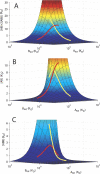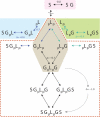Studying multisite binary and ternary protein interactions by global analysis of isothermal titration calorimetry data in SEDPHAT: application to adaptor protein complexes in cell signaling
- PMID: 17192587
- PMCID: PMC1794685
- DOI: 10.1110/ps.062558507
Studying multisite binary and ternary protein interactions by global analysis of isothermal titration calorimetry data in SEDPHAT: application to adaptor protein complexes in cell signaling
Abstract
Multisite interactions and the formation of ternary or higher-order protein complexes are ubiquitous features of protein interactions. Cooperativity between different ligands is a hallmark for information transfer, and is frequently critical for the biological function. We describe a new computational platform for the global analysis of isothermal titration calorimetry (ITC) data for the study of binary and ternary multisite interactions, implemented as part of the public domain multimethod analysis software SEDPHAT. The global analysis of titrations performed in different orientations was explored, and the potential for unraveling cooperativity parameters in multisite interactions was assessed in theory and experiment. To demonstrate the practical potential and limitations of global analyses of ITC titrations for the study of cooperative multiprotein interactions, we have examined the interactions of three proteins that are critical for signal transduction after T-cell activation, LAT, Grb2, and Sos1. We have shown previously that multivalent interactions between these three molecules promote the assembly of large multiprotein complexes important for T-cell receptor activation. By global analysis of the heats of binding observed in sets of ITC injections in different orientations, which allowed us to follow the formation of binary and ternary complexes, we observed negative and positive cooperativity that may be important to control the pathway of assembly and disassembly of adaptor protein particles.
Figures








Similar articles
-
Integration and global analysis of isothermal titration calorimetry data for studying macromolecular interactions.Nat Protoc. 2016 May;11(5):882-94. doi: 10.1038/nprot.2016.044. Epub 2016 Apr 7. Nat Protoc. 2016. PMID: 27055097 Free PMC article.
-
Assembly of the Sos1-Grb2-Gab1 ternary signaling complex is under allosteric control.Arch Biochem Biophys. 2010 Feb 15;494(2):216-25. doi: 10.1016/j.abb.2009.12.011. Epub 2009 Dec 22. Arch Biochem Biophys. 2010. PMID: 20005866 Free PMC article.
-
Analysis of cooperativity by isothermal titration calorimetry.Int J Mol Sci. 2009 Aug 4;10(8):3457-77. doi: 10.3390/ijms10083457. Int J Mol Sci. 2009. PMID: 20111687 Free PMC article. Review.
-
Allostery mediates ligand binding to Grb2 adaptor in a mutually exclusive manner.J Mol Recognit. 2013 Feb;26(2):92-103. doi: 10.1002/jmr.2256. J Mol Recognit. 2013. PMID: 23334917 Free PMC article.
-
SEDPHAT--a platform for global ITC analysis and global multi-method analysis of molecular interactions.Methods. 2015 Apr;76:137-148. doi: 10.1016/j.ymeth.2014.11.012. Epub 2014 Dec 2. Methods. 2015. PMID: 25477226 Free PMC article. Review.
Cited by
-
The membrane proximal proline-rich region and correct order of C-terminal tyrosines on the adaptor protein LAT are required for TCR-mediated signaling and downstream functions.Cell Signal. 2020 Dec;76:109790. doi: 10.1016/j.cellsig.2020.109790. Epub 2020 Sep 23. Cell Signal. 2020. PMID: 32979494 Free PMC article.
-
Engineering chromosome region maintenance 1 fragments that bind to nuclear export signals.Protein Sci. 2020 Jun;29(6):1366-1372. doi: 10.1002/pro.3724. Epub 2019 Sep 14. Protein Sci. 2020. PMID: 31495993 Free PMC article.
-
Thermodynamics of cooperative DNA recognition at a replication origin and transcription regulatory site.Biochemistry. 2010 Dec 7;49(48):10277-86. doi: 10.1021/bi1014908. Epub 2010 Nov 10. Biochemistry. 2010. PMID: 21047141 Free PMC article.
-
Cooperative assembly of a four-molecule signaling complex formed upon T cell antigen receptor activation.Proc Natl Acad Sci U S A. 2018 Dec 18;115(51):E11914-E11923. doi: 10.1073/pnas.1817142115. Epub 2018 Dec 3. Proc Natl Acad Sci U S A. 2018. PMID: 30510001 Free PMC article.
-
Ca2+ -induced structural changes and intramolecular interactions in N-terminal region of diacylglycerol kinase alpha.Protein Sci. 2022 Jul;31(7):e4365. doi: 10.1002/pro.4365. Protein Sci. 2022. PMID: 35762720 Free PMC article.
References
-
- Ababou, A. and Ladbury, J.E. 2006. Survey of the year 2004: Literature on applications of isothermal titration calorimetry. J. Mol. Recognit. 19: 79–89. - PubMed
-
- Arnaud, A. and Bouteiller, L. 2004. Isothermal titration calorimetry of supramolecular polymers. Langmuir 20: 6858–6863. - PubMed
-
- Bains, G. and Freire, E. 1991. Calorimetric determination of cooperative interactions in high affinity binding processes. Anal. Biochem. 192: 203–206. - PubMed
-
- Baker, B.M. and Murphy, K.P. 1997. Dissecting the energetics of a protein-protein interaction: The binding of ovomucoid third domain to elastase. J. Mol. Biol. 268: 557–569. - PubMed
-
- Baker, B.M. and Murphy, K.P. 1998. Prediction of binding energetics from structure using empirical parameterization. Methods Enzymol. 295: 294–315. - PubMed
MeSH terms
Substances
Grants and funding
LinkOut - more resources
Full Text Sources
Other Literature Sources
Research Materials
Miscellaneous

